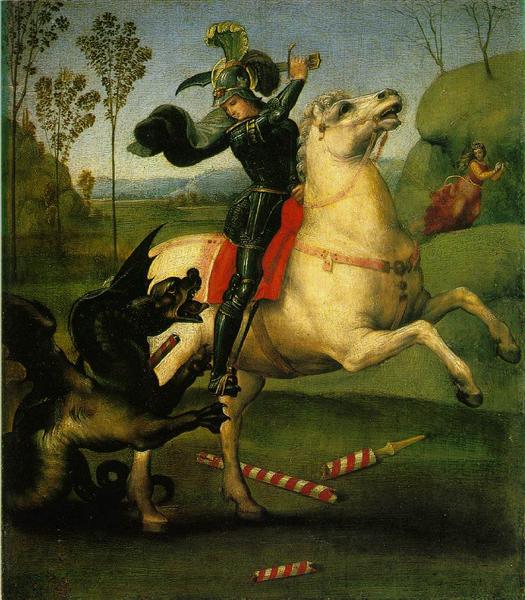Description
Raphael's Saint George and the Dragon, created in 1503, is a magnificent example of the Italian Renaissance, fusing technical virtues with profound symbolic narratives. This painting, an oil on panel, reveals the artist's skill in depicting both the human figure and the dynamic emotion of the scene. Raphael, still young in his career, already demonstrates in this work the mastery of space and light that would characterize his mature style.
At the centre of the composition we find Saint George, a noble and heroic knight who faces the dragon. His figure, mounted on a majestic white horse, is commanded by a sense of movement and determination. George is presented as the ideal of chivalry, with armour that reflects the codes of nobility and a lance that is stuck in the dragon's body, a representation that alludes to the struggle between good and evil. Saint George's posture is dynamic, his body in tension, which gives a sense of imminence to the action.
The dragon, in contrast, is a grotesque and diabolical creature, with scales of green and yellow hues, which stand out against the warmer palette surrounding the saint. This duality of color not only establishes a visual contrast, but also a symbolic one, where the light of the hero contrasts dramatically with the darkness of the beast. The background of the painting, with a landscape of hills and a clear sky, emphasizes the encounter between opposites: the struggle of the hero against the forces of evil, represented by the dragon that threatens the female figure prostrate at his feet.
A notable aspect of the work is the figure of the princess, who stands at the far right of the composition, watching in fear and hope. Her presence is vital, as she adds a narrative dimension to the scene; she is not only an object of St George’s salvation, but a symbol of the purification and redemption that the hero brings to humanity. She is a reminder that this story is not just about physical combat, but also about self-sacrifice and sacrifice.
Raphael employs a lighting technique that highlights specific figures and areas, a hallmark of Renaissance painting. The light bathing St. George highlights his heroic character, while the dragon is cast in evil shadow, accentuating his malignant nature. This use of chiaroscuro, along with the arrangement of the figures, demonstrates the development of the use of perspective in painting at the time, leading the viewer's gaze towards the hero in the centre.
The work also displays a high level of detail in the precisely faceted armour and hair of the figures, revealing Raphael's interest in ideal beauty and formal perfection, traits that would become increasingly present in his later work. Despite his youth, Raphael had already internalised the visual language of his contemporaries, such as Leonardo da Vinci and Michelangelo, and adapted it to his own style, creating a synthesis of Renaissance art.
In analyzing “Saint George and the Dragon,” it is essential to recognize Raphael’s blend of narrative, symbolism, and technique. The work not only depicts a mythical event, but is a testament to the Renaissance spirit, where art becomes a vehicle for delving into questions of morality, heroism, and an ideal worldview. This painting, which inhabits the crossroads of the sacred and the secular, remains a landmark in art history, resonating through the centuries as an enduring example of the struggle of good versus evil. Thus, “Saint George and the Dragon” is not just a visual tale; it is a hymn to the nobility of the human spirit, captured with a mastery that invites deep contemplation.
KUADROS ©, a famous painting on your wall.
Hand-made oil painting reproductions, with the quality of professional artists and the distinctive seal of KUADROS ©.
Painting reproduction service with satisfaction guarantee. If you are not completely satisfied with the replica of your painting, we will refund 100% of your money.

